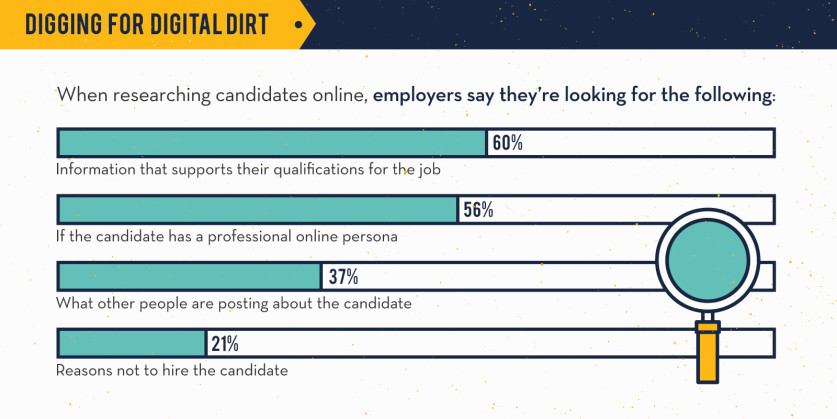
by Fronetics | Jan 27, 2016 | Blog, Leadership, Marketing, Social Media, Strategy
Should employers be monitoring or censoring employees’ social media?
 Censorship is always a hot-button issue, and, when combined with social media, things can heat up even more. The topic is debated in law school classrooms, at dinner parties, and in courtrooms. What should be shared and written on social media? Should companies censor what their employees post?
Censorship is always a hot-button issue, and, when combined with social media, things can heat up even more. The topic is debated in law school classrooms, at dinner parties, and in courtrooms. What should be shared and written on social media? Should companies censor what their employees post?
The waters still seem murky. Many companies don’t have policies around social media, but, with over 70% of online adults using Facebook, and the Internet-crazed Millennial generation now outnumbering Baby Boomers, they should look into putting some guidelines and policies into place.
Who’s Digging?
Many companies, up to 60%, now research candidates according to Career Builder. Up to 48% of companies who have researched candidates have found reasons not to hire them. According to the site, reasons range from provocative photos, references to drug or alcohol use, badmouthing a former employer or colleague, poor communication skills, and discriminatory comments.

Source: Career Builder
A New Generation
Although the retiring workforce does use the Internet (46% of those 65+, and 65% of those between ages 50-64), their numbers cannot compare to users in the younger, upcoming workforce (90% of those between 18-29).
The Millennial generation was born and raised in the digital age. Many of them have never heard of the Dewey Decimal System or know a life before cell phones. Their digital devices, and the Internet, have been their best way to research and connect. They are accustomed to throwing political views, photos, and personal experiences — good or bad — out into the cyber world. Many have already had the experience of poster’s regret, which might have taught them a lesson, but may also have blunted the idea of permanent mistakes. If one can delete a post and apologize, why not post away and worry later?
To Monitor or Not Monitor, That is the Question
Thinking carefully about what your expectations are of employees, and addressing those expectations in writing, is an important step to consider.
We assume that most employees know they shouldn’t post anything that damages the reputation of the company, its products, and employees, but it may be best not to assume. A case study in a recent Harvard Business Review provides a perfect example of what can happen if policies aren’t put into place.
In his Time piece, “Why Monitoring Employees’ Social Media is a Bad Idea,” author S. Kumar argues that while monitoring candidates might make sense, monitoring current employees breeds a suffocating and intrusive atmosphere:
“By allowing workers to live their personal lives without intrusion, smart businesses can make a powerful statement; namely, that they accept them for who they are, treasure their professional contributions to the company, and want them to be happy and fulfilled outside as well as inside the office. This, in turn, would inspire loyalty and boost productivity in the workforce, and make those companies more profitable.”
However you feel about the topic of monitoring, and even censoring, it’s important to be clear with employees about expectations. A general statement about employee behavior and representation of the company might be enough to instill deeper forethought when employees post, comment, and like.
Do you monitor your employees’ social media accounts? Do you have a policy in place that covers personal social media activity?

by Fronetics | Jan 12, 2016 | Blog, Leadership, Marketing, Strategy, Supply Chain, Talent

Recruiting and retaining top talent is one of the largest issues the supply chain faces today. It has, in many ways, become an industry of gaps: skills, talent, and gender, to name a few. How can companies secure their future by acquiring, developing, and keeping employees with the potential to undertake future leadership roles?
Fronetics Strategic Advisors works with clients to understand and execute on talent acquisition, performance management, learning and development, and succession management. We also work with clients to design and develop roles and responsibilities, on leadership development, mentoring and counseling, and on performance management and compensation strategies.
Here are our most-read talent articles of 2015:
While the number of full-time women in the workforce is up 15% since 1979, the number of women in the manufacturing sector is the lowest it has been since 1971.The gender gap extends more broadly to the supply chain, as well, with 70% and 80% of positions held by men. This article examines the talent crisis within the industry as an opportunity to help close the gender gap, and offers suggestions for building that bridge. Read the full article.
This interview with Rodney Apple, founder of the SCM Talent Group and supply chain recruiter for the majority of his 19-year career within the staffing industry, examines the challenges facing the industry and opportunities to address the talent crisis moving forward. Read the full article.
The outlook seems dire: by 2025, 60 million baby boomers will exit the workforce, leaving a gigantic gap when 40 million millennials take their place. What’s more, as few as 20% of the workforce will possess the broad range of skills required of 60% of all new supply chain jobs. The good news is that this looming crisis represents an ideal opportunity for recent college grads and mid-level supply chain management. Companies hoping to appeal to top candidates in the future should be proactive about meeting their professional needs through initiatives like competitive salaries and cross-functional training — or else, they might miss out. Read the full article.
Zappos offers new hires a $4,000 bonus to quit after an initial training program — and it actually has helped them retain top talent. Offering an early out to employees can be an effective method to detect personnel issues up front and ultimately can save your company from a major financial loss in the future. Read the full article.
When it comes to your career, connections matter. This article lists five reasons why building a strong network is crucial to your professional success. Read the full article.
Millennials — or, those born after 1981 — potentially could breathe new life into the graying supply chain industry. This article examines who millennials are and how companies might attract and retain talent within this oft-misunderstood generation. Read the full article.
Promising employees expect more from their employers when they outperform their peers — and not just in terms of compensation (though that is very important). When those expectations are met with disappointment, the company is at risk for losing top talent. This article discusses strategies for mitigating the loss of talented employees. Read the full article.
According to one study, only 12.5% of companies in the supply chain industry engage in formal succession planning, or the process of identifying top internal performers with the potential to fill key leadership positions. With the dearth of talent facing the supply chain, employers would be wise to invest in succession planning (and their most promising employees) — particularly through these three aspects of the process. Read the full article.
Focusing on education and training, employee retention and growth, and rethinking the talent pool itself does not address the bigger issue in the supply chain skills gap: the industry just isn’t perceived as sexy. What can companies do to overhaul their image and attract new and qualified talent? Read the full article.
Replacing employees is extremely costly — anywhere from 50 to 400% of their annual salaries, it is estimated — yet more than 2 million people voluntarily leave their jobs each month. Companies who are not tending to their human resource assets may be taking a major financial hit. Here are five employee retention strategies to help create a culture where employees are satisfied and interested in working for you long term. Read the full article.

by Fronetics | Jan 5, 2016 | Blog, Leadership, Strategy, Supply Chain

Fronetics Strategic Advisors is a leading management consulting firm. We work with organizations to identify and execute strategies for growth and value creation.
Good leadership is invaluable. At Fronetics we offer: leadership solutions for organizations during times of transition; leadership development solutions; thought leadership on important news and trends; talent acquisition and succession management guidance and support; and M&A support to help our clients build and capture value.
Two of the most-read leadership articles of 2015 were interviews with top female supply chain executives. Interviewing these women, Arrow Electronics’ Cathy Morris and Bravo Solutions’ Mickey North Rizza, was a highlight for me. Thank you again to both women for taking the time to talk with me and to share your thoughts on leadership, the supply chain, career development, and women in the supply chain.
The following are top 10 leadership articles of 2015:
Cathy Morris, senior vice president and chief strategy officer for Arrow Electronics, Inc., talks women in the supply chain and offers up career advice. Read the full article.
The world has changed a lot in a century, but Andrew Carnegie’s ideas on leadership have endured. Read the full article.
Mergers and acquisitions are increasingly popular strategies toward growth; however, 40% to 80% of mergers fail to meet objectives. M&A is complicated, and goes beyond simply “the process of buying a company.” At its heart, it is a strategic selection of competencies that fill a void in a company’s offering, geography, technology, or industry area of focus. It’s wise to think about whether the time, money, and energy are ultimately going to pay off, literally and figuratively.
There are some critical things to consider before courting a merger or acquisition. Be a leader by asking the tougher questions internally rather than focusing your team on an outside “target.” Read the full article.
There’s a great deal of buzz about social media in the business world — and for good reason. Marketing and communications professionals have made it de rigueur to tap into the popularity of social media networks to extend their brands into the digital world. But when it comes to executive use of social media, the field seems much more divided. Domo and CEO.com estimated that of the 500 leaders of the biggest companies in the US, 68% have no social media presence whatsoever. By leaving the social media management to marketers, these leaders are missing opportunities to connect with followers and expand their influence. Read the full article.
Businesses don’t fail; leaders do — a lot. Studies have shown that the rate of failure of executives coming into new companies ranges from 30 to 40 percent after 18 months. The costs and implications of a poor leadership hire are enormous. Given the odds, how can you hire a leader — a true leader? Read the full article.
When leaders fall prey to the busyness trap, time devoted to thinking and reflection is often minimized or eliminated; the result can be catastrophic. Freek Vermeulen, associate professor of strategy and entrepreneurship at the London Business School, cautions: “If you can’t find time to think, it probably means you haven’t organized your firm, unit, or team very well, and you are busy putting out little fires all the time. It also means that you are at risk of leading your company astray.” Read the full article.
Mickey North Rizza, VP, Strategic Services at BravoSolution, holds the distinction of Top Female Supply Chain Executive. She has 25 years of senior-level procurement, sourcing, and supply management experience. Mickey has also been an award-winning supply chain analyst with Gartner and AMR Research. In this interview, Mickey talks women in the supply chain. Read the full article.
The inability to delegate effectively is a principal reason why executives fail. According to London Business School Professor John Hunt, only 30% of managers think that they are able to delegate well. Among these individuals, only one-third are considered to be good delegators by their subordinates. Read the full article.
Women hold just 4.4% of CEO positions at S&P 500 companies, and this number is set to drop when Carol Meyrowitz steps down as CEO of TJX Companies, Inc. and moves into the role of executive chairperson. Looking globally, just 8% of companies with revenues of at least $500 million have a female CEO. Here’s the thing — the dearth of women in leadership positions is not just an issue of equality; it is also one of economics. When women are in positions of leadership, companies perform better — much better. Read the full article.
Whining. Just writing the word makes me cringe. Whining is a truly unattractive characteristic. It is unattractive in children, and it is even more unattractive when adults partake. One of the reasons why whining is just so unattractive is that it is ineffective and it can make a brilliant leader look like, well, like a blithering child. Read the full article.

by Fronetics | Nov 16, 2015 | Blog, Leadership, Strategy, Talent

Recently a friend left her job for a new job that offered more money, a better title, and exciting work. She spent much of the last days at her job feeling excited about her new prospect, but something in her was unsettled. She had spent much of the last decade at her job forming and fostering incredibly close friendships. She’s the kind of person who skips over the small talk and digs into the meat of someone’s life fairly quickly. The level of her friendships at work was most likely what was keeping here there for so many years. Leaving felt like a huge loss, even though she had so much to gain at her next job.
Make New Friends But Keep the Old
According to the Deloitte Global Human Capital Trends 2015 report, the first of the six “key findings” is that “softer” areas such as “culture and engagement, leadership and development have become urgent priorities.” Half of those surveyed said that culture and engagement were important to them. Companies who have an engaged workforce can boast up to 147% higher earnings per share.
A study conducted by Dr. Vanessa Boute at Plasticity Labs, confirms previous findings about the tie between valuing co-workers and job satisfaction. The study of over 450 employees showed that those who listed their co-workers as one of their top five things they’re grateful for were more satisfied and more engaged. According to the report, “people who value their co-workers are also more grateful and happy.”
Deep Talk Not Small Talk
We know there’s a connection between friendship and satisfaction, but how do we get people truly engaged with one another in the workplace? My friend, who likes to skip small talk and go straight to in-depth conversation, may be on to something.
According to several studies, people can form deep connections within an hour. One researcher, Arthur Aron, of State University of New York at Stony Brook, has been exploring interpersonal closeness for decades. He found that the kinds of questions you ask can make all the difference. If you ask superficial questions, in the way of small talk, bonds won’t be formed easily or quickly, however if you ask more meaningful questions people feel connected quite quickly. Rather than asking, “How did you spend your vacation?,” a question such as “What would constitute a perfect day for you and why?” will bring about more self-disclosure and more of a feeling of connectedness.
Space and Time
Allowing time in the workplace for employees to connect is critical to friendship development. These days many workplaces are dreary hives of fast production. Encourage mid-day group walks or lunches, and after-work outings. Plan staff development retreats and allow time and space for people to connect. When people have friends at work they will work harder in the end. The time a walk or lunch takes will come back to you and the company in the form of superb work and dedication. Think of that walk as an investment in the company’s future. People may not mind letting down a colleague, but they often mind letting down a friend.

by Fronetics | Nov 5, 2015 | Blog, Content Marketing, Data/Analytics, Leadership, Marketing, Strategy

We all want to see the fruits of our labors. Whether launching a product or a new social media campaign, we look for instantaneous numbers that will affirm we made the right choices. But here’s the problem: not all metrics are created equal.
So-called vanity metrics are measurements that have no bearing on your bottom line but can give you an inflated sense of success. Generally, they are easy to calculate but are influenced by too many factors—and are too vulnerable to random external events—to be reliable.
Website visits and number of subscribers are two classic examples. A spike in homepage hits may be the result of your marketing efforts, or it may be because of ghost spam. (Or, both.) Regardless, more visits do not necessarily correlate to increased revenue—just more visits. In the same vein, having 100,000 email subscribers means nothing if only 1% are opening them. You actually could be losing money in terms of resources allocated if the emails aren’t helping drive sales.
That’s why it is crucial to focus on return on investment instead of vanity metrics. You could waste hours reviewing a hundred different analytics that tell you nothing about how revenue was affected by a particular effort. Or, worse, you could use vanity metrics to justify decisions that don’t achieve their ROI.
As a simplified example: say you spend $100 on a banner ad for a new product on an industry conference website, and your analytics report that 100 people clicked through. This sounds like success! But don’t celebrate just yet. When you dig past the vanity metric, you find an extremely high bounce rate. That means most of those click-throughs left your site immediately, neither engaging with your brand nor moving any closer to becoming a customer. In fact, you find that only one click-through converts. Was it worth paying $100 for this one customer? Probably not.
But say you ran another $100 banner ad on an industry publication website, one that targets a younger audience than you think your product fits. Only 20 visitors clicked-through, which sounds less successful than the other ad. But when you follow those 20 click-throughs down the sales funnel, you see that 15 ended up purchasing $1500 worth of product. Already, the ad has paid for itself 15 times over. You’ve also learned that perhaps a younger audience is more suited to this product. The ROI proves the vanity metric was quite misleading in this case.
Lean-startup pioneer Eric Reis, who coined the term vanity metrics, said, “The only metrics that entrepreneurs should invest energy in collecting are those that help them make decisions.” In other words, measure the things that will tell you if an effort was profitable so you know where to put your time and money.
While vanity metrics tell you nothing about your bottom line, ROI can help you determine whether it was worth spending your resources in a particular way. This is extremely useful on platforms like blogs and social media, where things are constantly changing. Using ROI as a litmus test, you can keep experimenting and making sure you’re using these tools effectively. Tracking a vanity metric like number of followers, which is likely to build over time regardless, gives you no indication of which experiments were successful and which weren’t.
Your resources are limited, so it’s crucial to evaluate your efforts with meaningful numbers that illustrate their effect on your bottom line. Calculating ROI might take some time—both in the few extra minutes to do the math and the amount of time that needs to pass before all the data is available—but that number will be infinitely more valuable to you than any vanity metric on your Google Analytics report.
What metrics do you report to your team?
Related posts:
When it comes to marketing we work with our clients to create and execute strategies that drive success and elevate their brand position within the industry. Unlike other firms, we align marketing programs with business objectives and, through a data driven approach, are able to deliver results with a targeted ROI. Our team is comprised of strategists, marketing professionals, writers, designers, and experts in social media. Together we leverage our experience to increase brand awareness, position our clients as thought leaders, drive meaningful engagement with prospects and customers, and help businesses grow. Learn more

by Fronetics | Oct 29, 2015 | Blog, Leadership, Logistics, Strategy, Supply Chain
 We know that with the increasing growth of cyber-hacking and data breaches, investing in IT asset disposition (ITAD) is a growing necessity for companies. It is critical to ensure the safety of a company’s confidential live and stored data on all of its assets, ranging from computers, phones, servers, and hard drives. If breached, a company’s reputation, consumer base, finances and future viability are all at risk. What happens to data and technological gear after it is retired can be equally as critical as the current live data and in-service equipment. Proper disposal is not only important to the integrity and success of the company, its partners, and clients, but it may also protect the environment. While some sectors have strict regulations and requirements regarding ITAD, others do not, but whatever the case, the ethical obligation is huge.
We know that with the increasing growth of cyber-hacking and data breaches, investing in IT asset disposition (ITAD) is a growing necessity for companies. It is critical to ensure the safety of a company’s confidential live and stored data on all of its assets, ranging from computers, phones, servers, and hard drives. If breached, a company’s reputation, consumer base, finances and future viability are all at risk. What happens to data and technological gear after it is retired can be equally as critical as the current live data and in-service equipment. Proper disposal is not only important to the integrity and success of the company, its partners, and clients, but it may also protect the environment. While some sectors have strict regulations and requirements regarding ITAD, others do not, but whatever the case, the ethical obligation is huge.
The Cost of Hacking and Breaches
Akamai Technologies’ State of the Internet report showed that “hacker attacks on websites went up 75% in the final quarter of 2013, with hackers in China responsible for 43% of all attacks.” More recently, in 2014 the Cost of Cyber Crime Study was conducted by Ponemon and sponsored by HP. It found that crimes are more expensive, happen more frequently, and require more time to resolve than ever. It also found that crimes happened across various sectors (see below).
2014 Cost of Cyber Crime Study
- The average annualized cost of cyber crime was $12.7 million, with a range of $1.6 million to $61 million; an increase of 9 percent or $1.1 million over the average cost reported in 2013.
- There are an average of 138 successful attacks per week, compared to 50 attacks per week when the study was initially conducted in 2010.
- The average time to detect a malicious or criminal attack by a global study sample of organizations was 170 days. The longest average time segmented by type of attack was 259 days, and involved incidents concerning malicious insiders. The average time to resolve a cyber attack once detected was 45 days, while the average cost incurred during this period was $1,593,627 – representing a 33-percent increase over last year’s estimated average cost of $1,035,769 for a 32-day period.
ITAD: A Growing Business
According to TMR as reported in IT: Connect and Expand, the ITAD market will expand to $41 billion by 2019 on 141 million tons of used equipment. With the heavy responsibility that goes with ITAD in terms of proper wiping, disposal, reusing and recycling, more companies are working with 3rd-party service providers who specialize in ITAD. According to Business Wire 65 percent of companies larger than 10,000 workers, and up to one third of all businesses, are turning to 3rd-party service providers to manage end-of-life assets.
What if something goes wrong?
It makes sense with the increase of cyber crime that there would be cyber insurance. This may be one solution to protect yourself, however, according to observations made on the site Dark Reading, “cookie-cutter” cyber insurance might not be everything you need.
This post originally appeared on Electronics Purchasing Strategies.
You may also like:

 Censorship is always a hot-button issue, and, when combined with social media, things can heat up even more. The topic is debated in law school classrooms, at dinner parties, and in courtrooms. What should be shared and written on social media? Should companies censor what their employees post?
Censorship is always a hot-button issue, and, when combined with social media, things can heat up even more. The topic is debated in law school classrooms, at dinner parties, and in courtrooms. What should be shared and written on social media? Should companies censor what their employees post?





